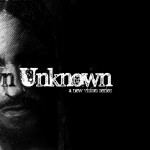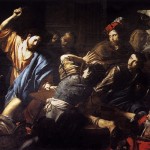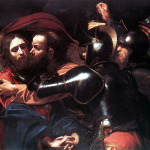Who is the naked man that runs away in Mark 14:51? At Jesus’ arrest and the disciples desertion, Mark states,
A young man, wearing nothing but a linen garment, was following Jesus. When they seized him he fled naked, leaving his garments behind.
The significance of this event cannot be understated. Why does Mark alone of the gospel writers offer this interesting detail?
There are four things I once found puzzling about Mark’s gospel.
- Jesus partial healing of a blind man. Why does he heal him twice?
- The man who runs away naked in the garden. Who is he?
- Mark sudden ending at 16:8. A fitting ending to the Good News?
- The resurrection meeting in Galilee. Why doesn’t Mark, like Luke, say Jesus met them in Jerusalem?
I’ve found the answer to these questions are essential to understanding Mark’s message – which is itself a question, a question which he now asks of us.
Jesus’ Journey
From the opening quotation, Mark defines the actions of Jesus as a journey.
It is written in Isaiah the prophet: ‘I will send my messenger ahead of you, who prepare your way (Malachi 2:9) a voice of one calling in the desert, Prepare the way for the Lord, make straight paths for him.’ (Isaiah 40:3)
The Call to Follow in Galilee
The first thing Jesus does in Mark is call men to join him on this journey.
- “Follow me,” he says to Peter and Andrew and immediately they leave everything to “follow him.” (1:16-18)
- He calls James and John and they too leave everything to “follow him.” (1:19-20)
- Jesus calls Levi the Tax collector. “Follow me,” he says and like those before him, Levi leaves everything to follow him. (2:14)
Mark tells us that Jesus chose the twelve Apostles that “they might be with him…” (3:14) Jesus’ selection is a call to nearness. To be His disciples means to follow where He goes.
And in Galilee this what the disciples do.
- They are with him when His mother and brothers come to take custody of him and when He speaks his first parable. (3:20-4:33)
- They are with him when he calmly quiets the storm and confronts a man possessed with a legion of demons. (4:35-20)
- They are with him when He heals the woman with the issue of blood and raises Jarius’ daughter from the dead. (5:21-43).
The disciples are with Jesus at every turn. But they don’t have a clue who He is.
As Jesus dramatically cuts his way through the pages of Mark, people are compelled to ask, “Who is this man?”
- “What is this, a new teaching with authority?” (1:27)
- “Why does this man speak that way? Who can forgive sins but God alone?” (2:7)
- “Why is He eating and drinking with tax collectors and sinners?” (2:16)
- “Why don’t your disciples fast?” (2:18)
- “Why are your disciples doing what is not lawful on the Sabbath?” (2:24)
But the disciples, those who are near to Jesus, are just as confused.
- They ask Jesus about his parables (4:10)
- They wonder at His cool reaction to a storm (4:38-41)
- They are dumbfounded when Jesus asks “who touched me?” (5:31)
- They are perplexed when Jesus instructs them to feed the five thousand (6:35-37)
- They are again perplexed when he tells them two chapters later to feed the four thousand (8:2-3)
They just don’t get it.
Mark depicts them as stupid!
When Jesus teaches plainly in Mark 7:14-15, the disciples turn around and ask for an interpretation of the parable (7:17-23). ITS NOT A PARABLE! A fact which underscores their total lack of intelligence.
And after Jesus feeds the five thousand and the four thousand with a few loaves of bread,, Mark tells us that he once again found them concerned about their lack of bread (8:14-16). Duh!
We may not like that Mark is hard the disciples because we relate. But that’s precisely why Mark holds them to this harsh light. He wants us to see ourselves in this bumbling group of men.
The Journey to Jerusalem
Something breaks in chapter eight. A brief sign of intelligence encourages Jesus to inform his followers of his ultimate plan. While the far north of Israel, Jesus asks his disciples the question everyone’s been dieing to know, “who do you say that I am.” Peter declares “You are the Christ.”
Finally the right answer!
But Peter is shocked when Jesus takes it in an unexpected direction. Jesus teaches here for first time teaches
the Son of Man must suffer many things and be rejected by the elders, chief priests and teachers of the law, and that he must be killed and after three days rise again. (8:31)
Peter appears to think that the “Christ” would be a conquering hero, a military leader who will kick the Romans out and reestablish the Kingdom of Israel. Jesus, however, rebukes Peter. He is a suffering Christ and not the Christ of Peter’s expectations.
Jesus then gathers his disciples and calls them once again to follow.
If anyone wishes to come after Me, he must deny himself and take up his cross and follow Me. For whoever wishes to save his life will lose it, but whoever loses his life for my sake and the gospels will save it.
Jesus is calling his disciples to follow him in his death.
This dramatic exchange is the beginning of the journey to Jerusalem. Mark structures the journey around three misunderstandings. Beginning with Peter’s confession, Jesus will teach three times that he must suffer, die and be raised again. Three times the disciples will think in ways contrary to this teaching. And three times he will correct their faulty understanding, teaching them what it means to truly follow. Jesus exchange with Peter is the first of these encounters.
We find the second instance in Mark 9:31. Jesus returns from the far north into Galilee and teaches his disciples once again that,
The Son of Man is to be delivered into the hands of men, and they will kill Him; and when He has been killed, he will rise three days later.
But the disciples still don’t understand and they are afraid to ask. When Jesus enters Capernaum, a city on the north shore of the Sea of Galilee, he questions them about what they were talking about “on the way.” Mark states,
But they kept silent, for on the way they had discussed with one another which of them was the greatest.
Their Lord has just proclaimed the nearness of his death and they are arguing about which one of them is the best. Like Peter they don’t understand the mission Jesus has in mind. Jesus once again sits them down and teaches another paradox.
If anyone wants to be first, he shall be last of all and the servant of all.
How many of us have seen these internal power plays, Christians envious and fighting over others prestige? Those prepared to die are never concerned about such things.
In 10:33 Jesus enters Judea and gives the most detailed description of his impending death yet.
Behold we are going up to Jerusalem, and the Son of Man will be delivered to the chief priests and the scribes; and they will condemn Him to death and will hand Him over to the Gentiles. They will mock Him and spit on Him, and scourge Him and kill Him, and three days later He will rise again.
But James and John in the very next verse approach Jesus with an astonishing request.
Grant that we may sit, one on Your right and one on Your left, in Your glory.
They just don’t get it. They still think that Jesus is going to be crowned king in Jerusalem. They’re looking forward to being close to an earthly king. Jesus responds,
You do not know what you are asking. Are you able to drink the cup that I drink, or to be baptized with the baptism with which I am baptized?
They reply all to rashly,
we are able.
Jesus affirms that they will indeed be able but as for sitting on his right and left he cannot grant because
it is for those for whom it has been prepared.
Surprisingly, the only other people we find in the gospel of Mark that are ever on Jesus right and left are the two thieves on the cross. It is evident from Mark that Jesus glory is the cross and here he’s once again calling them to follow him on the road.
Jesus again teaches a paradox.
Whoever wishes to become great among you shall be your servant; and whoever wishes to be first among you shall be slave of all. For even the Son of Man did not come to be served but to serve, and to give His life a ransom for many.
But sadly the disciples never get it. When they finally arrive in Jerusalem, they show themselves to be tragically and traitorously inept. Judas, one of the twelve, goes to the leaders and offers to betray Jesus. When Jesus predicts this, Peter and the other disciples respond with oaths of loyalty. But in Gethsemane, Mark states that at the sight of the soldiers, “they all left him and fled.”
At the sight of the soldiers, the disciples abandon their call. At the first sign of danger, they all run away. Jesus has called them to follow him to his death. He has called them to suffer. The disciples choose life instead.
It is here in this moment that we find the young man.
A young man, wearing nothing but a linen garment, was following Jesus. When they seized him. He fled naked, leaving his garment behind.
Who is this man and why does Mark tell us about him? There are some interesting clues.
- First, a linen sheet only appears one other time in the gospel of Mark and its wrapped around the dead body of Jesus.
- Secondly, nakedness, after the fall, is always a sign of shame.
For these reasons as well as one other that I will reveal in a moment I believe Mark uses this young man as a symbol for the very failure of the disciples. They have been called to follow Jesus in his death but in that moment they all run away in shame leaving the death that Christ has clothed them in behind.
Shocking! The disciples, the very twelve apostles, when confronted with the death that Christ demands turn around and flee. But they are our fathers, they are our representatives. And like them we Fat Christians have abandoned Christ’s call. I’m sure each of us can remember the sweetness of our conversion when Christ first called us to follow. Like the disciples we left everything. Like their time in Galilee, the beginning was trouble-free. It was easy to follow because everything was so sweet. But as the years passed life seemed to seep back in. We got married, had some kids, bought a house in which live. Now there were mortgages to pay, vacations to plan, and cars to fix and repair. We sought people and places that would affirm us. We’ve looked for glory in the eyes of others. Suffering for Christ became the last thing on our minds. And now it’s not a question whether we would follow him to his death for we ceased to follow all ready. Like the disciples we’ve already denied him. We’ve already turned and walked away. Examined in light of Christ’s own example we find ourselves totally lacking. Can we do what Jesus did? Can we walk the road he himself has blazed?
That’s the powerful question in Mark’s disturbing ending. Mark tells us that the women who go to the tomb on Sunday Morning are met by a young man clothed in white. Notice how Mark alone among the gospels doesn’t call this figure an angel. Instead he calls him a “young man.” It’s the same description used for the streaking disciple, the young man that runs away in the Gethsemane, leaving the linen sheet behind. Well, now he’s clothed in white and he has a message for the disciples. “’He is going before you into Galilee; there you will see Him, just as He said to you.” But again in the very next verse the women, like the disciples before, run away and say nothing for they themselves are afraid. The end? Yup, that’s it.
All the questions you had about the disciples, Mark doesn’t answer. Did they go to Galilee? Did they meet Jesus again? He doesn’t say. Why not? Why doesn’t he say? Answer: Because he leaves it to you. Without denying the difficulty, Jesus extends his forgiveness in reestablishing the call. He goes before you. Will you follow? The answer and the end is up to you.
















